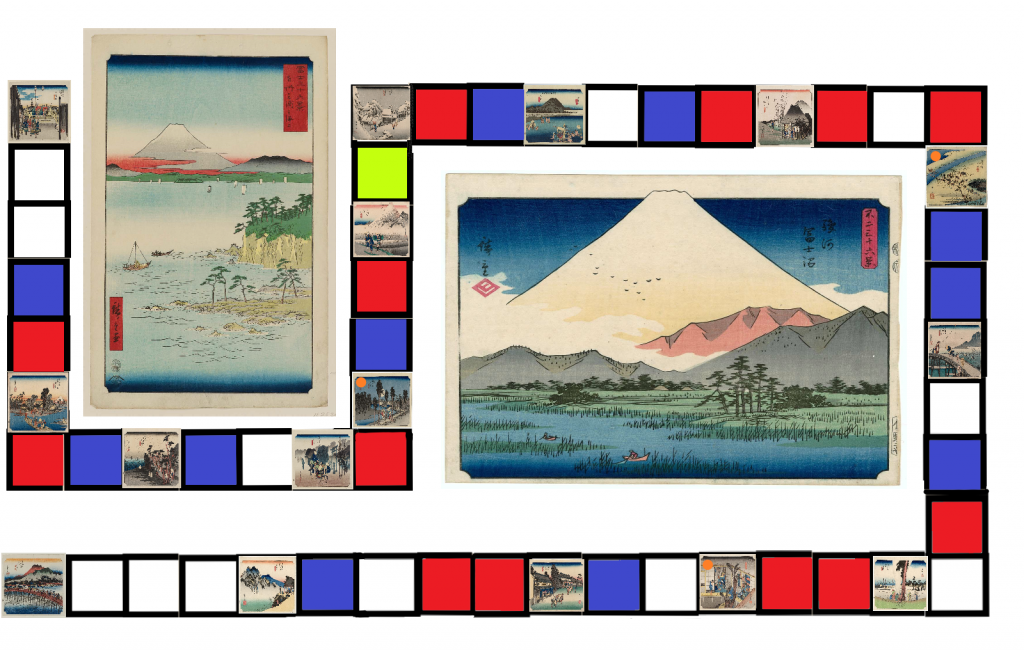by Leo Cheng

You are a wealthy merchant living in 1850s Japan. You have been a fan of Ando Hiroshige’s works and his work “53 Stations of Tokaido” has inspired you to travel along the Tokaido and visit Kyoto. As Japan opens to foreigners for trade and repaves the Tokaido, it has become more accessible than ever before so now would be the best time to go on your pilgrimage. As you have never travelled along the Tokaido before, your knowledge of the Tokaido is only based on Ando Hiroshige’s “53 Stations of the Tokaido,” so you have no idea what awaits you. You start saving up your ryo for the pilgrimage and think about what you could possibly encounter and the different people you will meet. You let your family know of your plans to go on this pilgrimage and initially you are hit with some disagreement as they warn you of the dangers of travelling alone. Also, they remind you that you need to save enough money for them as you are the primary income of the family. You reassure them that everything will be fine as long as you do not anger the daimyo or samurai that are also using the path and you also tell them that you have been saving up for a considerable amount of time and have more than enough to both embark on the pilgrimage and have enough to feed your family. After some consideration, your family hesitantly agrees, and you start getting ready for the pilgrimage. You start by heading into the market to find some food to bring along for your journey, you learn that along the way, the locals along the Tokaido provide food and cheap lodging for your journey. With the primary concern of food and lodging out of the way, you start to get ready for your pilgrimage. You go to a nearby temple to pray for good fortune and head home. The next day, you continue packing different sets of clothing for your journey and head out one last time to the markets of Edo. You buy some additional cloth for remuneration along the journey if needed and go home one last time. In the morning, with crystal clear skies, you look over at Mount Fuji and think to yourself, “I will see you up close soon.” You exchange goodbyes for your family for now and head out the shoji. With one ryo in your kimono and some extra food you have packed for the beginning of your journey, you head over to Nihonbashi where you will start your journey.
Bibliography
“Nagoya Castle, Home of the Owari Tokugawa Samurai: 昇龍道 SAMURAI Story.” Nagoya Castle, Home of the Owari Tokugawa Samurai | 昇龍道 SAMURAI Story, Central Japan Tourism Association, go-centraljapan.jp/route/samurai/en/spots/detail.html?id=20
Sekino, Junʼichirō, 1914-, Robert McClain, and University of Oregon. Museum of Art. The Fifty-three Stations of the Tōkaidō: Wood Block Prints. [Eugene, Or.]: Visual Arts Resources, Museum of Art, University of Oregon, 1978.
Crawcour, E. S., and Kozo Yamamura. “The Tokugawa Monetary System: 1787-1868.” Economic Development and Cultural Change, vol. 18, no. 4, 1970, pp. 489–518. JSTOR, www.jstor.org/stable/1152130. Accessed 7 Apr. 2021.
Hiroshige, Ando. “The Fifty-Three Stations of the Tōkaidō Road.” Great Tōkaidō, Takenouchi Magohachi and Tsuruya Kiemon, www.hiroshige.org.uk/Tokaido_Series/Tokaido_Great.htm.
Hiroshige, Ando. “Thirty-Six Views of Mount Fuji.” 36 Views of Mount Fuji, Sanoki, www.hiroshige.org.uk/36_Views_Mount_Fuji/36_Views_Mount_Fuji.htm.
Schumacher, Mark. Guide to Japanese Pilgrims, Pilgrimages, Holy Mountains, Sacred Shrines, Mark Schumacher, www.onmarkproductions.com/html/pilgrimages-pilgrims-japan.html.